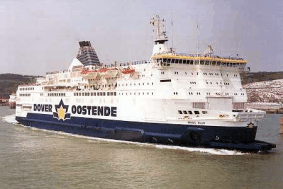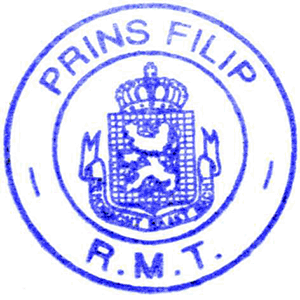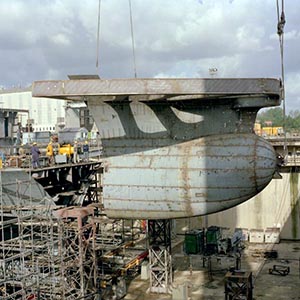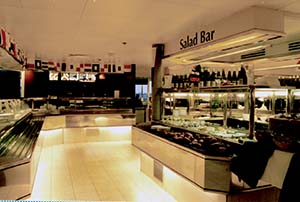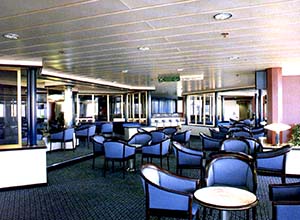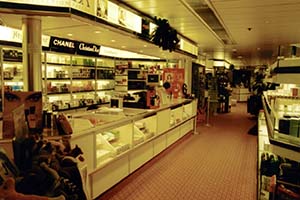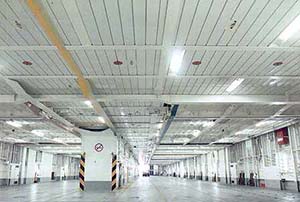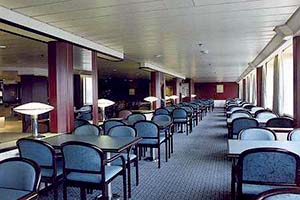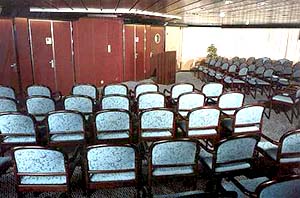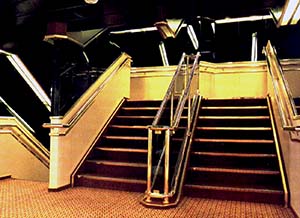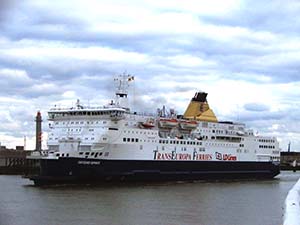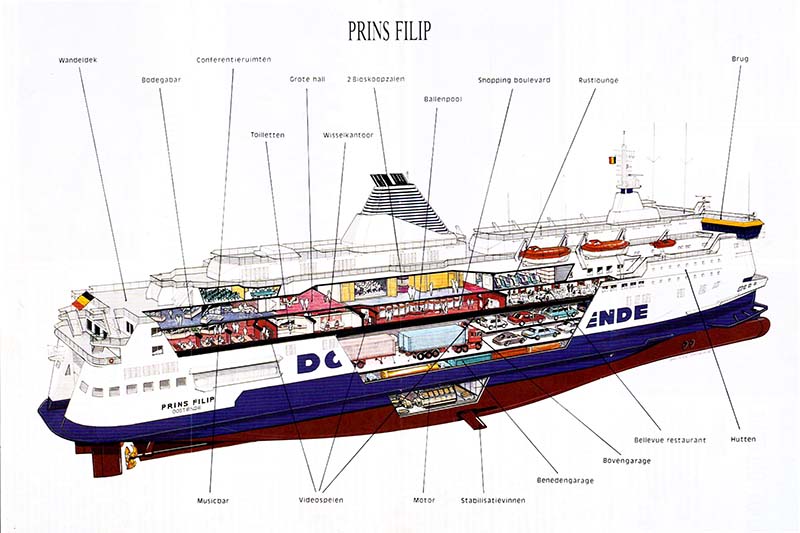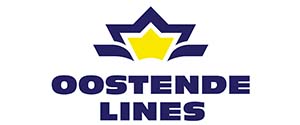
De Prins Filip werd in 1990 te Temse gebouwd bij Boelwerf als bouwnummer 1534. De lancering had plaats op 1 maart 1991 maar de levering heeft hindernissen ondervonden door een groot aantal storingen die nog door de werf dienden te worden verholpen. De eerste datum van levering was voorzien eind juni 1991 zodat het schip het zomerseizoen van 91 kon worden ingezet. De problemen bepaalden echter anders. Zo’n 1500 problemen werden door de Rmt afgevaardigden vastgesteld waaraan oplossingen dienden gegeven. Let wel dat gaat over allerlei kleine en grote mankementen. Maar op een schip zoals dit met zoveel technologie aan boord was dit geen overdreven situatie.
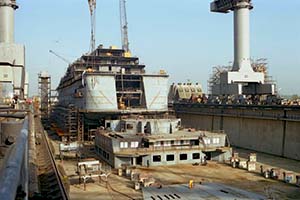
De belangrijkste problemen van de vertraging waren te reduceren tot drie zware ingrepen. Tijdens de afwerking bleek de Noorse firma belast met de binnen afwerking failliet. Onderaannemers diende het werk over te nemen. Bij testen bleek er trillingen van het boegschroef hinderlijk te zijn dat door het schip tot aan de brug zwaar werden gevoeld. De apparatuur op de brug kon hierdoor mogelijk gestoord worden. Hiervoor werden de cabines in het voorschip terug gestript en dienden versterkingen in de constructie aangebracht zodat de trillingen niet meer door het schip voelbaar waren. Tevens werkte het M.E.S. systeem (evacuatie systeem) niet naar voldoening. Een aangepast systeem diende opnieuw ingebouwd.
Anderzijds werd gemeld dat het schip uiterst tevredenheid genoot inzake gedrag en maneuvreerbaarheid. Dit was reeds uitvoerig bestudeerd tijdens de simulaties in Denemarken. Het grote schip was uiteraard een totaal ander vaartuig inzake afmetingen voor de haven van Oostende.
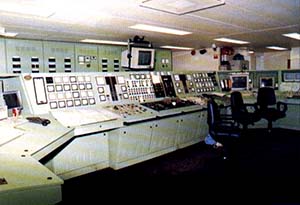
Op 27 april 1992 werd het schip aan de RMT geleverd en kwam op 28 april in Oostende. De volgende dagen werden diverse afvaarten zonder reizigers ondernomen om de bemanningen aan het schip vertrouwd te laten geraken. De bemanningen die voor de Prins Filip waren aangeduid werden ondertussen door de andere ploegen “Filipino’s” genoemd.
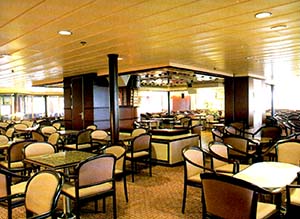
Op 12 mei werd het schip feestelijk ingehuldigd in aanwezigheid van de toenmalige Minister Guy Coëme. Een special bedrijfskrant bracht hierover verslag. Ook de toenmalige Prins Filip bracht een persoonlijk bezoek aan het schip. Fier als een pauw hebben we gewacht op zijn hoogheid nadat we de ganse dag alles piekfijn in orde hebben gebracht. Op 15 mei was dan de eerste officiële afvaart naar Dover.
Werken aan boord van dit schip was een eer. De variatie, aangename sfeer en omgeving deed de duur van een werkdag of reis voorbij vliegen. Ook met de collega’s van diverse afdelingen was het zeer aangenaam samenwerken. Elk zette zich volledig in voor zijn afdeling wat tot een goed draaiend geheel zorgde. Uiteraard hadden we vele nieuwe middelen ter beschikking. Om bvb maar te noemen was er het display systeem waarmee we aankondigingen op de TV schermen konden plaatsen. Dat systeem werd door een PC (nog een 286 processor) gestuurd. We hadden een paging systeem ter beschikking om elkaar te contacteren bij dringende gevallen. De Purser had drie assistenten ter beschikking en dat was soms geen luxe op een vol schip. Bij drukke bezetting kon ik genieten om eens overal te gaan kijken als alles in orde was maar ook om te zien hoe de reizigers genoten van het comfort op dit schip. Als ik wat tijd had durfde ik de Disco Bar nog opstarten voor een uurtje om wat ambiance in de bar te brengen.
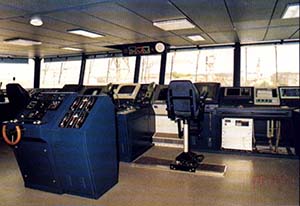
De promotiefilm van de Prins Filip kan u bekijkebn via deze link: Promotiefilm
Vanaf de start werd er heel wat promotie voor dit schip gevoerd. Het schip had namelijk alles te bieden om een aangename overtocht te garanderen. Onze taak als assistent purser was meestal om toe te zien dat alles goed verliep. Zo was er regelmatig een actie van groepen die het Business dek hadden gehuurd voor een conferentie of activiteit. Of zelfs met valentijn konden op een nachtreis verliefde koppeltje een reisje maken en werden eens in de watten gelegd in het restaurant . Na het uitgebreid tafelen kon men naar de cinema of nog een bezoekje aan de bar brengen om dan tijdens de terugreis in een hut te verdwijnen voor een dutje. Of ja, je weet wel. Non-Landing passengers zoals we dat noemden. Men kon zelfs boeken met de wagen en nog wat blijven slapen na aankomst te Oostende. Stay Overnight boeking heette dat. ’s Morgens werden dan de reizigers gewekt en een ontbijt aangeboden in het restaurant vooraleer te ontschepen en hun reis verder te zetten.
Aan boord waren 121 hutten. 41 (4 bedden) passagiershutten en 80 binnen hutten met twee bedden die voor de vrachtwagenchauffeurs werden voorbehouden. De passagiershutten die meestal op elke nachtreis waren vol geboekt. Zelfs de 2 luxe (2 persoons bed) hutten die tamelijk duur waren. Als hutman moesten we heel goed voorbereid zijn om bij aanvang inscheping zo snel mogelijk de juiste hut aan de juiste reservatie te geven. De reizigers kregen aan het bureel na controle van het ticket de juiste sleutel en konden snel de hut betrekken. Tegen vertrek van het schip was dit karwei geklaard. De hutten waren voorzien van een VingCard 1080 locking systeem.
Op 10 januari 1993 kon de Prins Filip het hoofd niet bieden met twee sleepboten tijdens een hevige storm en raakte de Eastern Docks Pier waardoor schade aan stuurboord werd gemaakt. De schade werd tussen 13 en 29 januari in Antwerpen hersteld.
Op 31 december 1993 deed de Prins Filip met onze ploeg de laatste reis naar Dover. Ik zal dat moment te Dover niet gauw vergeten daar ik als laatste de container met documenten te Dover in ontvangst nam en mijn Engelse collega nog een hand gaf. Hij weende en zei: “I am so sorry to see you Belgians leave”. Tja, na zoveel Jaren Dover verlaten was dan ook een bijzonder moment.
Veel tijd voor emotie hadden we niet want het schip was afgehuurd door een Luikse firma voor een speciale nieuw jaar gelegenheid “La traversée de minuit”.
Vanaf 1994 startte de samenwerking met Sally en ging de Rmt naar de haven van Ramsgate. Dit was een bijzonder gebeuren en de Engelse havenautoriteiten waren in de wolken met deze samenwerking. In de hoop de economie rond Ramsgate wat terug te doen opleven. Voor de commandanten was het invaren van de haven Ramsgate ook een hele wijziging ten opzichte van Dover. De lange en smalle geul om de haven in te varen vergde toch heel wat zeemanschap. De inspanningen van Sally waren gedreven om een uitstekende service op te bouwen. Men had zwaar geïnvesteerd in de bouw van aanlegposten en infrastructuur. Jammer dat op 14 september 1994 de nieuwe walkway van Ramsgate instortte en zes mensenlevens eiste.
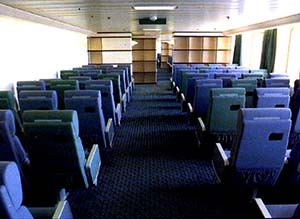
Begin 1995 werd de Prins Filip door de Rmt aangekocht.
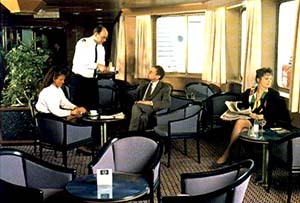
Op 20 februari brak bij een storm de vastmaking van de Jetfoil Terminal Ponton en dreef in de haven. Hierdoor diende de Prins Filip zo’n 14 uur te wachten om de haven binnen te varen. De haven van Ramsgate was niet zo goed beschermd als deze van Dover. Bij krachtige wind bleek het toch een wel lastig maneuver. Op 11 april 1996 liep de Prins Filip zelfsq even vast op een zandbank voor Ramsgate maar kon gelukkig zonder schade na een paar uur zelf los geraken.
Zo waren we op een nachtreis binnengevaren en stak er plots een hevige wind op. We hadden reeds alle reizigers in de hutten gewekt en laten klaar maken om naar de garage en de auto te gaan. De Prins Filip slaagde er echter niet in om in die hevige wind te maneuvreren en diende snel door sleepboten te worden geholpen. Omdat we zagen dat dit wel even zou duren hebben we de reizigers op de hoogte gebracht en terug de hut gegeven om verder te kunnen rusten. Ook gerust gesteld dat we wel zouden wekken als het schip klaar zou zijn. De hevige wind blies het schip richting kaaimuur. Gelukkig konden de sleepboten verhinderen dat het schip de muur raakte en zo schade zou oplopen. Na een uur of drie nam de wind in kracht af en kon de commandant het schip aanmeren. Onze reizigers hebben dankbaar gebruik gemaakt van een paar uurtjes extra slaap en verlieten het schip goedgemutst.
Uit respect voor de situatie op de brug hebben we de communicatie met de brug beperkt tot het minimum teneinde correcte info te kunnen geven aan ons cliënteel. De volgende dagreis kregen we van de commandant een waardering voor onze houding.
Op 28 februari 1997 deden we dan ook de laatste reis met de Prins Filip naar Ramsgate. De aandacht was uiteraard groot en er was media aan boord. Velen wilden nog die laatste reis meemaken en voor ons was het de laatste werkdag voor de Rmt. Een drukke werkdag. Na aankomst te Oostende ben ik naar huis gegaan en in bed gekropen. Het gevoel van dat moment is me vandaag nog altijd even sterk als toen.
Na de sluiting is de Prins Filip op 25 april 1997 naar Duinkerke vertrokken tot het schip kon verkocht worden. Dat was het geval op 25 juni 1998 wanneer de Prins Filip aan Stena Ferries, Ltd, Hamilton, Bermuda werd verkocht. De volgende maand kreeg ze al de verdiende naam “Stena Royal”. Ze werd aan P&O Stena Line gecharterd om ingezet te worden op Zeebrugge – Dover.
Op 14 mei 1999 kreeg ze de nieuwe naam bij P & O “Aquitane” en werd onder Engelse vlag geregistreerd. Pas in november 1999 is de ex PF naar Dover gegaan als passagiersschip en car ferry na een vernieuwbouw in Falmouth.
Op 27 april 2000 is er iets op de brug fout gegaan bij het aanmeren in Calais en raakte hevig de aanlegpost. Zo’n veertig reizigers werden verwond waaronder drie ernstig.
Op 28 april is er zo’n 3 meter van de bulpsteven weggenomen in Duinkerke en is het schip op 5 mei in Falmouth scheepswerf aangekomen voor de volledige herstelling die eind mei kon afgerond.
In februari 2003 kreeg ze de nieuwe naam “Pride of Aquitane” tot op 17 mei 2005 de lijn werd stop gezet en op 6 juni uit dienst naar Duinkerke is gegaan.
Op 13 september 2005 is het schip dan aan Louis Dreyfus Ferry SAS, Italy verkocht en hernoemd tot “Norman Spirit”. Deze werd ingezet op de lijn Le Havre –Portsmouth.
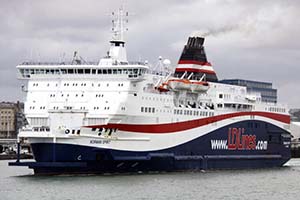
Na een paar jaar stilte kwam de ex PF terug in 2010 naar Oostende als de “Ostend Spirit” en werd terug ingezet voor Trans Europa Ferries op de lijn Oostende – Ramsgate. Omdat ik dagelijks de trein naar Brugge moest nemen was het pijnlijk om dit mooie schip en haar herinneringen telkens voor mijn neus te zien liggen. Het heeft echter niet lang geduurd omdat in maart 2011 de samenwerking met LD lines en Trans Europa Ferries werd stop gezet. Het schip kreeg dan ook terug de naam “Norman Spirit”.
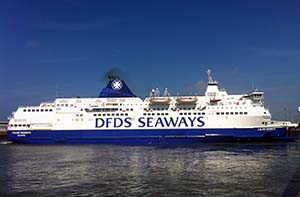
In maart 2013 werd het schip door DFDS Seaways opnieuw ingezet op de Calais –Dover route en vaart er nog steeds onder de naam “Calais Seaways”.
Sedert mei 2022 vaart de ex Prins Filip als "Isle of Innisfree" voor Irish Ferries tussen Calais en Dover.
We vinden mooie beeld op Youtube van het schip via deze link.
Na 30 jaar is het schip binnenin niet meer herkenbaar. Of toch?

